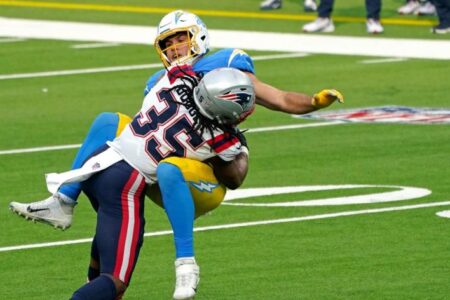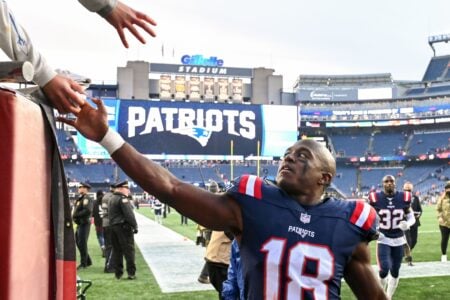fourthandmiles
On the Game Day Roster
- Joined
- Aug 8, 2007
- Messages
- 466
- Reaction score
- 0
Registered Members experience this forum ad and noise-free.
CLICK HERE to Register for a free account and login for a smoother ad-free experience. It's easy, and only takes a few moments.What is it that makes a LB successful in the 3-4? What skill set is needed/desired? What is it that most LBs lack that makes them a bad fit? Both for ILB and OLB.
OLB: 1) gotta be stout enough to set the edge 2) fluid enough to drop in coverage 3) explosive enough to rush the passer
The problem is that college 4-3 DEs are often question marks on both #1 & #2, and are more often not, notable because of their ability to rush the passer on the edge. College 4-3 OLBs are generally just too small to do either #1 or #3 for us, and often project inside in a 3-4.
ILB: 1) strong enough to stack & shed blockers 2) fluid enough to drop in coverage 3) added bonus is any interior pass rushing ability
The problem here is that not many college LBs, OLB or ILB, really show much stack & shed ability. There's a lot of sideline to sideline guys, guys who run around blocks.
You should check out the draft board here, there is constantly interesting discussions about these above issues.
OLB: 1) gotta be stout enough to set the edge 2) fluid enough to drop in coverage 3) explosive enough to rush the passer
The problem is that college 4-3 DEs are often question marks on both #1 & #2, and are more often not, notable because of their ability to rush the passer on the edge. College 4-3 OLBs are generally just too small to do either #1 or #3 for us, and often project inside in a 3-4.
ILB: 1) strong enough to stack & shed blockers 2) fluid enough to drop in coverage 3) added bonus is any interior pass rushing ability
The problem here is that not many college LBs, OLB or ILB, really show much stack & shed ability. There's a lot of sideline to sideline guys, guys who run around blocks.
You should check out the draft board here, there is constantly interesting discussions about these above issues.
What is it that makes a LB successful in the 3-4? What skill set is needed/desired? What is it that most LBs lack that makes them a bad fit? Both for ILB and OLB.
As a question related to this thread, I'm wondering if someone who knows the NFL and this team back further than I can remember (at least into the 80's and 70's) can give a little history of the 3-4. Who invented it? Did it come to the Patriots from the Bill Parcells coaching tree? or earlier or later than that? What trends have existed for the 3-4 over time. i.e., has it come in and out of popularity? It seems to be on the rise now compared to 10 years ago, but I'd appreciate a bit more info than I have on the matter. Thanks.
Nice summary, but what about the relative priority of the characteristics? Here is my take on your list:
OLB:
1) gotta be stout enough to set the edge
Must have or the defense unwinds like pulling a loose thread on a sweater. This is why a clearly limited Vrabel was so valuable for the 2008 Pats and is the biggest question mark for his replacement.
2) explosive enough to rush the passer
Most of the QB pressure is applied from the OLB and we know what happens with a lack of pressure. Vrabel had nothing left is this area and is likely why he is in KC now. AD is a demon here and IMO needs to be kept outside.
3) fluid enough to drop in coverage
I listed this lower since the Pats OLB seem to drop into shallow zones a lot. However, this is the skill that can really make a huge difference if done well. Before his latest injury, Colvin was doing a great job in reading routes and quickly getting in the right area.
ILB:
1) fluid enough to drop in coverage
The game has changed and that is why I tune out anyone who mentions Ted Johnson or Two-down. So many teams throw quick passes on first down to get into workable down-distance situations. If an ILB isn't solid in disrupting these West Coast routes, I'm not sure how you keep them on the field for anything but short yardage. Bruschi still has the instincts, but the physical skills have diminished to the point where he just can't make plays in the passing game.
2) strong enough to stack & shed blockers
May be strange to see this 2nd, but I think you can be a successful Pats ILB without excelling here. The OLBs seal the edge (2 blockers) and the DL eats up the OL (at least 4 blockers). Add in the QB and the RB and that only leaves 3 potential blockers left, including wideouts. As long as the ILBs don't get blown up, it is likely one of them will be clean enough to make a tackle if they hit the right hole at the right time. Again, Bruschi seems late to the party more times than not.
Stack? Sure, can't run around blockers and can't let them put you on the ground. Shed? Great if you can get it, but not at the expense of #1 above.
3) added bonus is any interior pass rushing ability
I'm hoping this becomes a more important part of the Pats scheme. But for now, it would seem to be an "added bonus" as you indicated.
That depends on which 3-4 you are running, but Patriots specific:
- An ILB needs to be able to take on blockers such as...
-- Offensive Linemen trying to block the second level to create a rush lane;
-- Tight Ends lead blocking for the runner;
-- Full Backs lead blocking for the runner;
-- and Wide Receivers cracking back to clear an outside lane.
- The ILB can either stack & shed the blocker(s) to make the tackle, or just stack him to close the hole and redirect the runner, or slip around the blocker with good hand technique and quickness to beat the runner into the hole.
- The ILB needs to be STRONG or capable of getting stronger, QUICK with great feet for moving through trash without getting tripped up and beating blockers with quick hands to keep them from locking onto him, SMART to not only make play calls and adjustments, but to also read and understand blocking schemes, ALERT and AWARE to read and adjust and to find the ball amidst a sea of big bodies.
- That's the run game. He also needs to learn to cover Running Backs, Tight Ends, and Wide Receivers working within his area.
-- He needs to understand coverages,
-- his role in the coverage,
-- and be capable of playing his assignment in Man and Zone.
-- He needs to be able to find the ball in the air.
- It helps if he can generate a pass rush, but it's not as important a function for an ILB.
- Finally, he needs to be able to TACKLE - the most critical skill of them all and one too often overlooked (like with Maualuga's fan club who discount all the missed tackles he doesn't make).
All of the ILB's skillset applies to the OLB, the big difference is the OLB really needs to be able to get pressure on the Quarterback in the passing game. Sacks are nice, but there are other ways to create pressure (clogging the throwing lane, collapsing the pocket, hurrying the throw, forcing the passer to move and reset his feet, stripping the ball out of his hands to force a fumble, and batting the ball down at the Line of Scrimmage).
Nice summary, but what about the relative priority of the characteristics? Here is my take on your list:
OLB:
1) gotta be stout enough to set the edge
Must have or the defense unwinds like pulling a loose thread on a sweater. This is why a clearly limited Vrabel was so valuable for the 2008 Pats and is the biggest question mark for his replacement.
2) explosive enough to rush the passer
Most of the QB pressure is applied from the OLB and we know what happens with a lack of pressure. Vrabel had nothing left is this area and is likely why he is in KC now. AD is a demon here and IMO needs to be kept outside.
3) fluid enough to drop in coverage
I listed this lower since the Pats OLB seem to drop into shallow zones a lot. However, this is the skill that can really make a huge difference if done well. Before his latest injury, Colvin was doing a great job in reading routes and quickly getting in the right area.
ILB:
1) fluid enough to drop in coverage
The game has changed and that is why I tune out anyone who mentions Ted Johnson or Two-down. So many teams throw quick passes on first down to get into workable down-distance situations. If an ILB isn't solid in disrupting these West Coast routes, I'm not sure how you keep them on the field for anything but short yardage. Bruschi still has the instincts, but the physical skills have diminished to the point where he just can't make plays in the passing game.
2) strong enough to stack & shed blockers
May be strange to see this 2nd, but I think you can be a successful Pats ILB without excelling here. The OLBs seal the edge (2 blockers) and the DL eats up the OL (at least 4 blockers). Add in the QB and the RB and that only leaves 3 potential blockers left, including wideouts. As long as the ILBs don't get blown up, it is likely one of them will be clean enough to make a tackle if they hit the right hole at the right time. Again, Bruschi seems late to the party more times than not.
Stack? Sure, can't run around blockers and can't let them put you on the ground. Shed? Great if you can get it, but not at the expense of #1 above.
3) added bonus is any interior pass rushing ability
I'm hoping this becomes a more important part of the Pats scheme. But for now, it would seem to be an "added bonus" as you indicated.
:nono: The 'we don't need no stinkin' stack&shed' crowd are on a roll, don't cool them down with reality - James Laurinaitis is the next Tedy Bruschi.Tedy played a lot of Will LB, where taking windows and rip & run is more available as an option due to heavy strong side run team tendencies. When he played a lot of Mike, he seemed to struggle.
:nono: The 'we don't need no stinkin' stack&shed' crowd are on a roll, don't cool them down with reality
me said:Stack? Sure, can't run around blockers and can't let them put you on the ground. Shed? Great if you can get it, but not at the expense of #1 above.
:nono: The 'we don't need no stinkin' stack&shed' crowd are on a roll, don't cool them down with reality - James Laurinaitis is the next Tedy Bruschi.
34 year old version.














